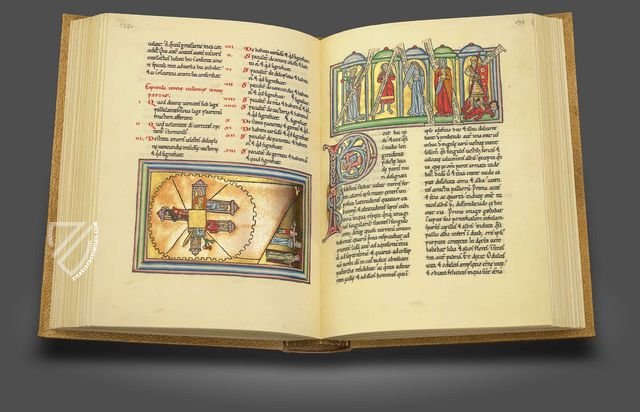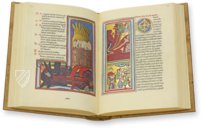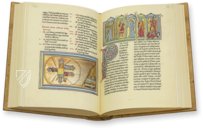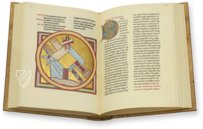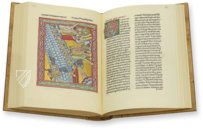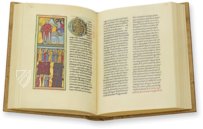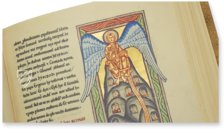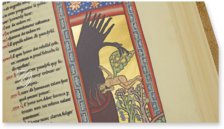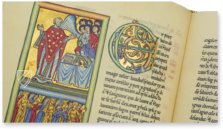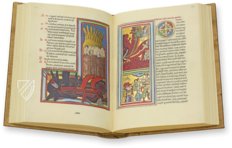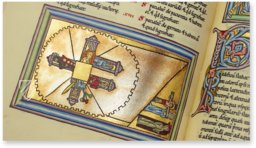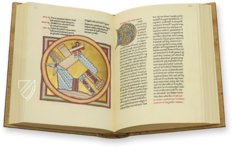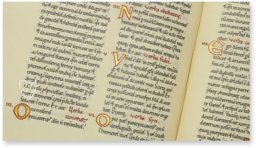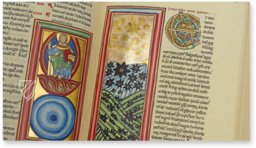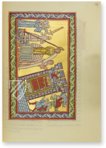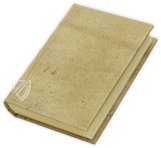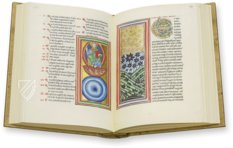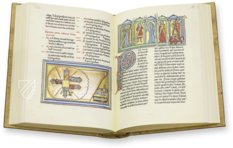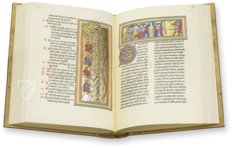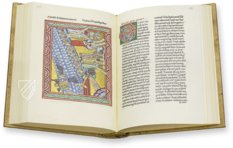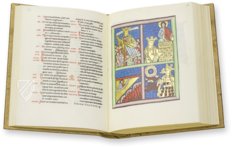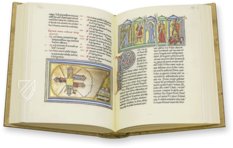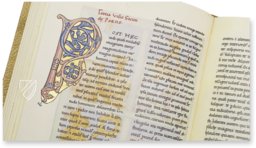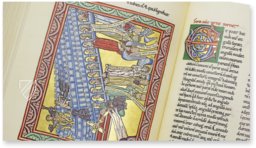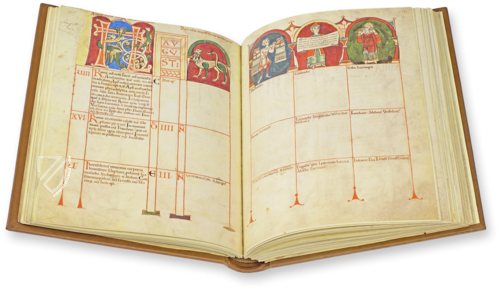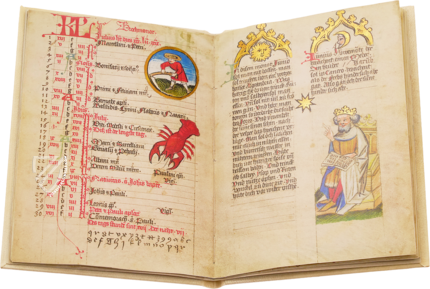Liber scivias
Hildegard von Bingen (1098–1179) is one of the most interesting figures of the Middle Ages and was probably the most prolific female author of her time, writing on topics ranging from theology to botany. The Liber Scivias – “Know the Ways” – is Hildegard's first theological-cosmological work. The later abbess of Rupertsberg Abbey began having visions at a young age and became one of the most famous Christian mystics of the Middle Ages. She spent more than ten years recording her visions in a book whose central idea is the inseparable oneness of the universe (macrocosm) and humankind (microcosm). Although many copies of this work were made during and after Hildegard's lifetime, the Rupertsberg Scivias Codex from 1175, with its 35 colorful and vivid miniatures, is undoubtedly the most magnificently illuminated of them all. Although the original was lost in the chaos of World War II, fortunately, Rupertsberg nuns had made an exact copy of it between 1927 and 1933, which is still preserved today.
Liber Scivias
Almost no woman in the history of the Middle Ages has been so received, appreciated, and adored throughout time – even up to the present day – as cloister-founder Hildegard von Bingen (1098–1179). More than 900 years later, her charisma continues to shine through the ages. Liber Scivias – “Know the Way” – is the first theological-cosmological work of Hildegard and it continues to provide us with prophetic guidance today. The book deals with the inseparable oneness of the Universe (macrocosm) and man (microcosm); showing the way of salvation – not only of man but also the world and cosmos as a whole - from the creation of the world and man to his redemption through Christ and the church up to the end of time. This book, which Hildegard worked on for over ten years and has been presented throughout history in the form of various manuscripts, is a testimony to her reputation as prophet, teacher, writer, and Christian mystic. Visions were nothing new for Hildegard, who began at the age of 3 to have what she called extraordinary perceptions termed visio. These came “not from a dream, nor in sleep or mental confusion, not by way of the naked eye or the audible ear, but rather I received them in a waking state, of sound mind and body, through the eyes and ears of inner man in the most isolated of places, as God had intended.” At the beginning of each section is a “vision” of striking presence and at the same time, soft eloquence, which creates a relationship of man to God, his renunciation and subsequent return to his creator. Through the richly colored forms contained in each visio, the invisible is becomes visualized.
A Manuscript Worthy of Hildegard's Visions
However, only one manuscript of the many made can be truly considered luxurious and richly illuminated: the famous Rupertsberg SCIVIAS-Codex from 1175; created during Hildegard’s lifetime in the monastery of Rupertsberg and decorated with 35 magnificent miniatures. It is as though she has created a window to the heavens and to transcendence in this codex – with a neologism: “fenestraliter”, which constitutes a prophetic faithful existence man still deeply longs for today. We owe the fact that the Rupertsberg SCIVIAS was not lost during the confusion of the times to the deceased nun in question: the Abbess Regentrudis Sauter, the 36th such and successor of Hildegard, wanted to dedicate it to the Golden anniversary of the order. During the years 1927 – 1933, the codex was taken out of the State Library in Wiesbaden and transferred to the abbey where four nuns took six years to write the text in exact accordance with the original and copy the miniatures by hand. No one could have known at the time that this authentic, true to the original, and extremely valued copy would become the only remaining codex – the original having been lost during the turmoil of the Second World War in 1945. This invaluable treasure is consequently guarded and kept in safe-keeping with great pride and diligence.
The Facsimile of Liber Scivias
To produce a facsimile edition of a missing manuscript presents many uncommon and trying challenges: many details can only be verified on the basis of descriptions and second-hand sources, thus making the volume Liber Scivias even the more valuable. The nuns provided their own timely version of the cover, however, this did not reflect the actual state of the cover at the time of its disappearance. According to records from the year 1931, a detailed description is given of the original volume of the codex lost during the war: the number of existing embossments and fittings, as well as the remaining clasps on the leather volume. As well, we know that the singular stamp used on the Liber Scivias is the same as the one on the so- called Giant Codex of Hildegard of Bingen (Hs.2). A further piece of helpful information was available to us: the Liber Scivias was completely photographed in 1920. Even though the quality of these 90 year-old black-and-white photos is not in accordance with today’s standards, the comparison of the photos of the original missing codex with that of the existing “Giant Codex” allows us to, as exactly as is possible, reconstruct the original volume of the Liber Scivias.
Codicology
- Alternative Titles
- Rupertsberger Codex
Liber scivias von Hildegard von Bingen - Size / Format
- 242 pages / 32.5 × 23.5 cm
- Origin
- Germany
- Date
- Ca. 1175 The lost original manuscript was copied by hand between 1927 and 1933 by nuns in Abbey of St. Hildegard
- Epochs
- Style
- Genre
- Language
- Script
- Protogothic minuscule
- Illustrations
- 35 gold- and silver-decorated miniatures, 16 of which are full-page, 15 half-page, 4 smaller miniatures, as well as 27 splendid decorated initials
- Content
- Theological-cosmological work dealing with the inseparable oneness of the Universe (macrocosm) and man (microcosm)
- Artist / School
- Hildegard von Bingen (1098–1179) (author)
- Previous Owners
- Abbey of St. Hildegard in Rüdesheim
State Library in Wiesbaden
Liber Scivias
The Last Judgement
Presented in dramatic fashion with plenty of gold leaf, Hildegard von Bingen’s vision of the Last Judgement shows Christ seated in a round mandorla, the wounds of the Crucifixion clearly visible in his red skin. Sometimes referred to as the Day of the Lord, it is initially referred to in prophetic Old Testament books like Joel and Isaiah, the phrase is often used to refer to catastrophic events like an invasion and has been used to identify both the first and second comings of Christ.
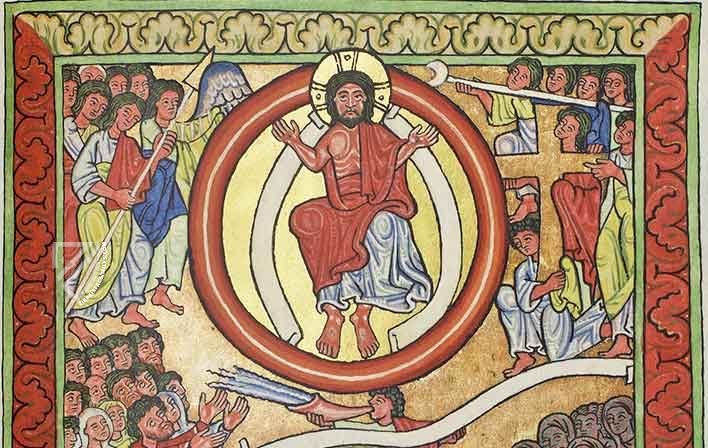
Liber Scivias
The Choirs of Angels
In one of her visions, Hildegard von Bingen saw nine angelic choirs singing together, all arranged with numerological and spiritual connotations. The first two are grouped together, symbolizing the body and soul of man, the next five rows represent the five senses of man purified by the wounds of Christ, and the last two represent the duel love for God and one’s neighbor.
As the rows get closer to God, represented by a field of white in the center because God’s mystery is veiled from man, the angels are of ever-increasing rank and holiness. "All these rows sounded in all sorts of music and announced miracles in wondrous harmonies the wonders, which God works in holy souls – a high song of glorification of God." (Scivias I.6.)
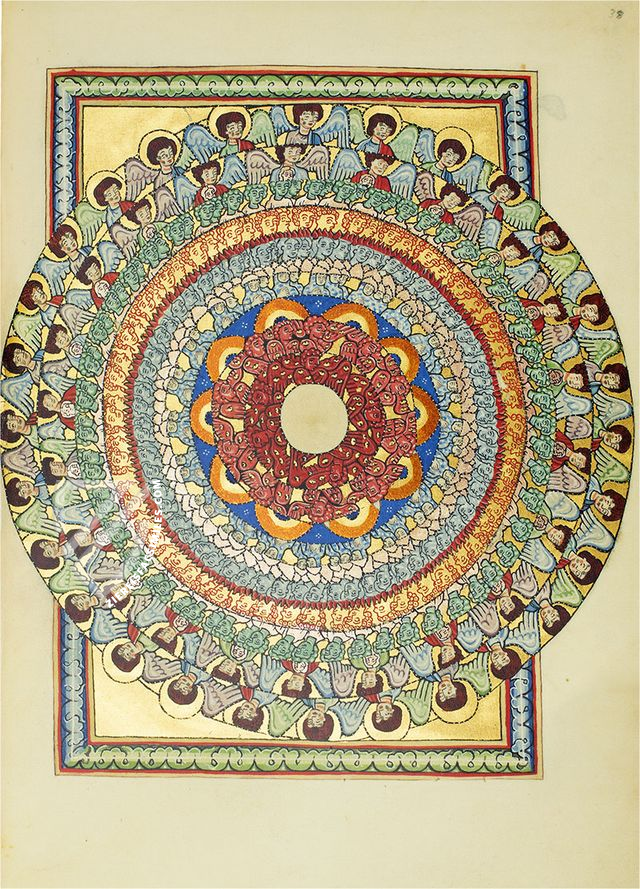
#1 Liber Scivias (Normal Edition)
Language: German
#2 Liber Scivias (Luxury Edition)
Language: German
(over 10,000€)
- Treatises / Secular Books
- Apocalypses / Beatus
- Astronomy / Astrology
- Bestiaries
- Bibles / Gospels
- Chronicles / History / Law
- Geography / Maps
- Saints' Lives
- Islam / Oriental
- Judaism / Hebrew
- Single Leaf Collections
- Leonardo da Vinci
- Literature / Poetry
- Liturgical Manuscripts
- Medicine / Botany / Alchemy
- Music
- Mythology / Prophecies
- Psalters
- Other Religious Books
- Games / Hunting
- Private Devotion Books
- Other Genres
- Afghanistan
- Armenia
- Austria
- Belgium
- Belize
- Bosnia and Herzegovina
- China
- Colombia
- Costa Rica
- Croatia
- Cyprus
- Czech Republic
- Denmark
- Egypt
- El Salvador
- Ethiopia
- France
- Germany
- Greece
- Guatemala
- Honduras
- Hungary
- India
- Iran
- Iraq
- Israel
- Italy
- Japan
- Jordan
- Kazakhstan
- Kyrgyzstan
- Lebanon
- Liechtenstein
- Luxembourg
- Mexico
- Morocco
- Netherlands
- Palestine
- Panama
- Peru
- Poland
- Portugal
- Romania
- Russia
- Serbia
- Spain
- Sri Lanka
- Sweden
- Switzerland
- Syria
- Tajikistan
- Turkey
- Turkmenistan
- Ukraine
- United Kingdom
- United States
- Uzbekistan
- Vatican City
- A. Oosthoek, van Holkema & Warendorf
- Aboca Museum
- Ajuntament de Valencia
- Akademie Verlag
- Akademische Druck- u. Verlagsanstalt (ADEVA)
- Aldo Ausilio Editore - Bottega d’Erasmo
- Alecto Historical Editions
- Alkuin Verlag
- Almqvist & Wiksell
- Amilcare Pizzi
- Andreas & Andreas Verlagsbuchhandlung
- Archa 90
- Archiv Verlag
- Archivi Edizioni
- Arnold Verlag
- ARS
- Ars Magna
- ArtCodex
- AyN Ediciones
- Azimuth Editions
- Badenia Verlag
- Bärenreiter-Verlag
- Belser Verlag
- Belser Verlag / WK Wertkontor
- Benziger Verlag
- Bernardinum Wydawnictwo
- BiblioGemma
- Biblioteca Apostolica Vaticana (Vaticanstadt, Vaticanstadt)
- Bibliotheca Palatina Faksimile Verlag
- Bibliotheca Rara
- Boydell & Brewer
- Bramante Edizioni
- Bredius Genootschap
- Brepols Publishers
- British Library
- C. Weckesser
- Caixa Catalunya
- Canesi
- CAPSA, Ars Scriptoria
- Caratzas Brothers, Publishers
- Carus Verlag
- Casamassima Libri
- Centrum Cartographie Verlag GmbH
- Chavane Verlag
- Christian Brandstätter Verlag
- Circulo Cientifico
- Club Bibliófilo Versol
- Club du Livre
- CM Editores
- Collegium Graphicum
- Collezione Apocrifa Da Vinci
- Comissão Nacional para as Comemorações dos Descobrimentos Portugueses
- Coron Verlag
- Corvina
- CTHS
- D. S. Brewer
- Damon
- De Agostini/UTET
- De Nederlandsche Boekhandel
- De Schutter
- Deuschle & Stemmle
- Deutscher Verlag für Kunstwissenschaft
- DIAMM
- Droz
- E. Schreiber Graphische Kunstanstalten
- Ediciones Boreal
- Ediciones Grial
- Ediclube
- Edições Inapa
- Edilan
- Editalia
- Edition Deuschle
- Edition Georg Popp
- Edition Leipzig
- Edition Libri Illustri
- Editiones Reales Sitios S. L.
- Éditions de l'Oiseau Lyre
- Editions Medicina Rara
- Editorial Casariego
- Editorial Mintzoa
- Editrice Antenore
- Editrice Velar
- Edizioni Edison
- Egeria, S.L.
- Eikon Editores
- Electa
- Emery Walker Limited
- Enciclopèdia Catalana
- Eos-Verlag
- Ephesus Publishing
- Ernst Battenberg
- Eugrammia Press
- Extraordinary Editions
- Fackelverlag
- Facsimila Art & Edition
- Facsimile Editions Ltd.
- Facsimilia Art & Edition Ebert KG
- Faksimile Verlag
- Feuermann Verlag
- Folger Shakespeare Library
- Franco Cosimo Panini Editore
- Friedrich Wittig Verlag
- Fundación Hullera Vasco-Leonesa
- G. Braziller
- Gabriele Mazzotta Editore
- Gebr. Mann Verlag
- Gesellschaft für graphische Industrie
- Getty Research Institute
- Giovanni Domenico de Rossi
- Giunti Editore
- Graffiti
- Grafica European Center of Fine Arts
- Guido Pressler
- Guillermo Blazquez
- Gustav Kiepenheuer
- H. N. Abrams
- Harrassowitz
- Harvard University Press
- Helikon
- Hendrickson Publishers
- Henning Oppermann
- Herder Verlag
- Hes & De Graaf Publishers
- Hoepli
- Holbein-Verlag
- Houghton Library
- Hugo Schmidt Verlag
- Idion Verlag
- Il Bulino, edizioni d'arte
- ILte
- Imago
- Insel Verlag
- Insel-Verlag Anton Kippenberger
- Instituto de Estudios Altoaragoneses
- Instituto Nacional de Antropología e Historia
- Istituto dell'Enciclopedia Italiana - Treccani
- Istituto Ellenico di Studi Bizantini e Postbizantini
- Istituto Geografico De Agostini
- Istituto Poligrafico e Zecca dello Stato
- Italarte Art Establishments
- Jan Thorbecke Verlag
- Johnson Reprint Corporation
- Josef Stocker
- Josef Stocker-Schmid
- Jugoslavija
- Karl W. Hiersemann
- Kasper Straube
- Kaydeda Ediciones
- Kindler Verlag / Coron Verlag
- Kodansha International Ltd.
- Konrad Kölbl Verlag
- Kurt Wolff Verlag
- La Liberia dello Stato
- La Linea Editrice
- La Meta Editore
- Lambert Schneider
- Landeskreditbank Baden-Württemberg
- Leo S. Olschki
- Les Incunables
- Liber Artis
- Library of Congress
- Libreria Musicale Italiana
- Lichtdruck
- Lito Immagine Editore
- Lumen Artis
- Lund Humphries
- M. Moleiro Editor
- Maison des Sciences de l'homme et de la société de Poitiers
- Manuscriptum
- Martinus Nijhoff
- Maruzen-Yushodo Co. Ltd.
- MASA
- Massada Publishers
- McGraw-Hill
- Metropolitan Museum of Art
- Militos
- Millennium Liber
- Müller & Schindler
- Nahar - Stavit
- Nahar and Steimatzky
- National Library of Wales
- Neri Pozza
- Nova Charta
- Oceanum Verlag
- Odeon
- Orbis Mediaevalis
- Orbis Pictus
- Österreichische Staatsdruckerei
- Oxford University Press
- Pageant Books
- Parzellers Buchverlag
- Patrimonio Ediciones
- Pattloch Verlag
- PIAF
- Pieper Verlag
- Plon-Nourrit et cie
- Poligrafiche Bolis
- Presses Universitaires de Strasbourg
- Prestel Verlag
- Princeton University Press
- Prisma Verlag
- Priuli & Verlucca, editori
- Pro Sport Verlag
- Propyläen Verlag
- Pytheas Books
- Quaternio Verlag Luzern
- Reales Sitios
- Recht-Verlag
- Reichert Verlag
- Reichsdruckerei
- Reprint Verlag
- Riehn & Reusch
- Roberto Vattori Editore
- Rosenkilde and Bagger
- Roxburghe Club
- Salerno Editrice
- Saltellus Press
- Sandoz
- Sarajevo Svjetlost
- Schöck ArtPrint Kft.
- Schulsinger Brothers
- Scolar Press
- Scrinium
- Scripta Maneant
- Scriptorium
- Shazar
- Siloé, arte y bibliofilia
- SISMEL - Edizioni del Galluzzo
- Sociedad Mexicana de Antropología
- Société des Bibliophiles & Iconophiles de Belgique
- Soncin Publishing
- Sorli Ediciones
- Stainer and Bell
- Studer
- Styria Verlag
- Sumptibus Pragopress
- Szegedi Tudomànyegyetem
- Taberna Libraria
- Tarshish Books
- Taschen
- Tempus Libri
- Testimonio Compañía Editorial
- Thames and Hudson
- The Clear Vue Publishing Partnership Limited
- The Facsimile Codex
- The Folio Society
- The Marquess of Normanby
- The Richard III and Yorkist History Trust
- Tip.Le.Co
- TouchArt
- TREC Publishing House
- TRI Publishing Co.
- Trident Editore
- Typis Regiae Officinae Polygraphicae
- Union Verlag Berlin
- Universidad de Granada
- University of California Press
- University of Chicago Press
- Urs Graf
- Vallecchi
- Van Wijnen
- VCH, Acta Humaniora
- VDI Verlag
- VEB Deutscher Verlag für Musik
- Verlag Anton Pustet / Andreas Verlag
- Verlag Bibliophile Drucke Josef Stocker
- Verlag der Münchner Drucke
- Verlag für Regionalgeschichte
- Verlag Styria
- Vicent Garcia Editores
- W. Turnowski Ltd.
- W. Turnowsky
- Waanders Printers
- Wiener Mechitharisten-Congregation (Wien, Österreich)
- Wissenschaftliche Buchgesellschaft
- Wissenschaftliche Verlagsgesellschaft
- Wydawnictwo Dolnoslaskie
- Xuntanza Editorial
- Zakład Narodowy
- Zollikofer AG

